Designers agree that a dining room rug can instantly ground a table, absorb sound, and inject personality—yet the best choice hinges on durability, scale, and style. Recent trend reports highlight warmer earth tones, bold graphic motifs, and sustainable materials, while practical guides still stress low-pile construction and generous sizing so chairs glide smoothly without catching. Homes & Gardens The Home Depot Below, you’ll find twenty distinct, field-tested ideas—each 100–120 words—to help you match form and function and create a dining space that feels every bit as inviting as the meals you serve.
1. Persian-Style Dining Room Rug for Timeless Anchoring
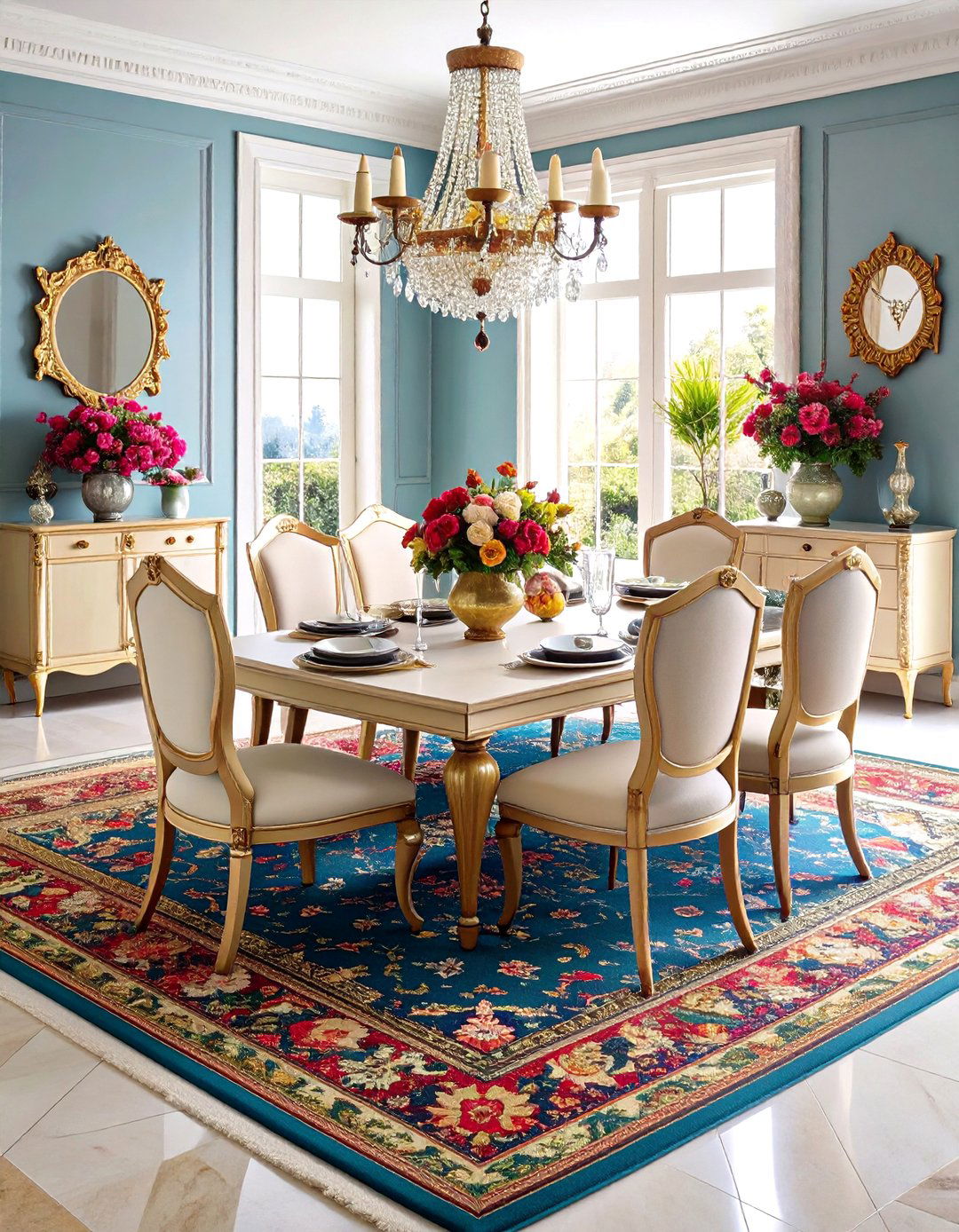
A storied Persian dining room rug instantly lends gravitas, its medallions and floral borders echoing centuries of craft while camouflaging occasional spills within layered pattern. Look for modern power-loomed versions with easy-care polyester or polypropylene fibers if heirloom wool exceeds your budget; these update tradition without sacrificing stain resistance. Designers at House Beautiful recommend vintage-look Persian pieces to “offer a more traditional vibe” and pair seamlessly with everything from Louis chairs to mid-century tulip tables. House Beautiful The Spruce
2. Indoor-Outdoor Dining Room Rug for Spill-Proof Ease

For households with kids, pets, or pasta-sauce enthusiasts, an indoor-outdoor dining room rug woven from solution-dyed polypropylene is a lifesaver. Recent tests on a geometric Wayfair bestseller show it shrugging off wine, mud, and UV rays while still feeling “super soft” underfoot—perfect when the dining zone doubles as homework central. Southern Living Choose a flat weave or low-medium pile so chair legs glide, then simply hose-off outdoors or spot-clean inside. The durable fibers also resist mildew, making this idea ideal for a sun-filled breakfast nook or a dining area that opens onto a patio.
3. Washable Dining Room Rug Keeps Life Stress-Free
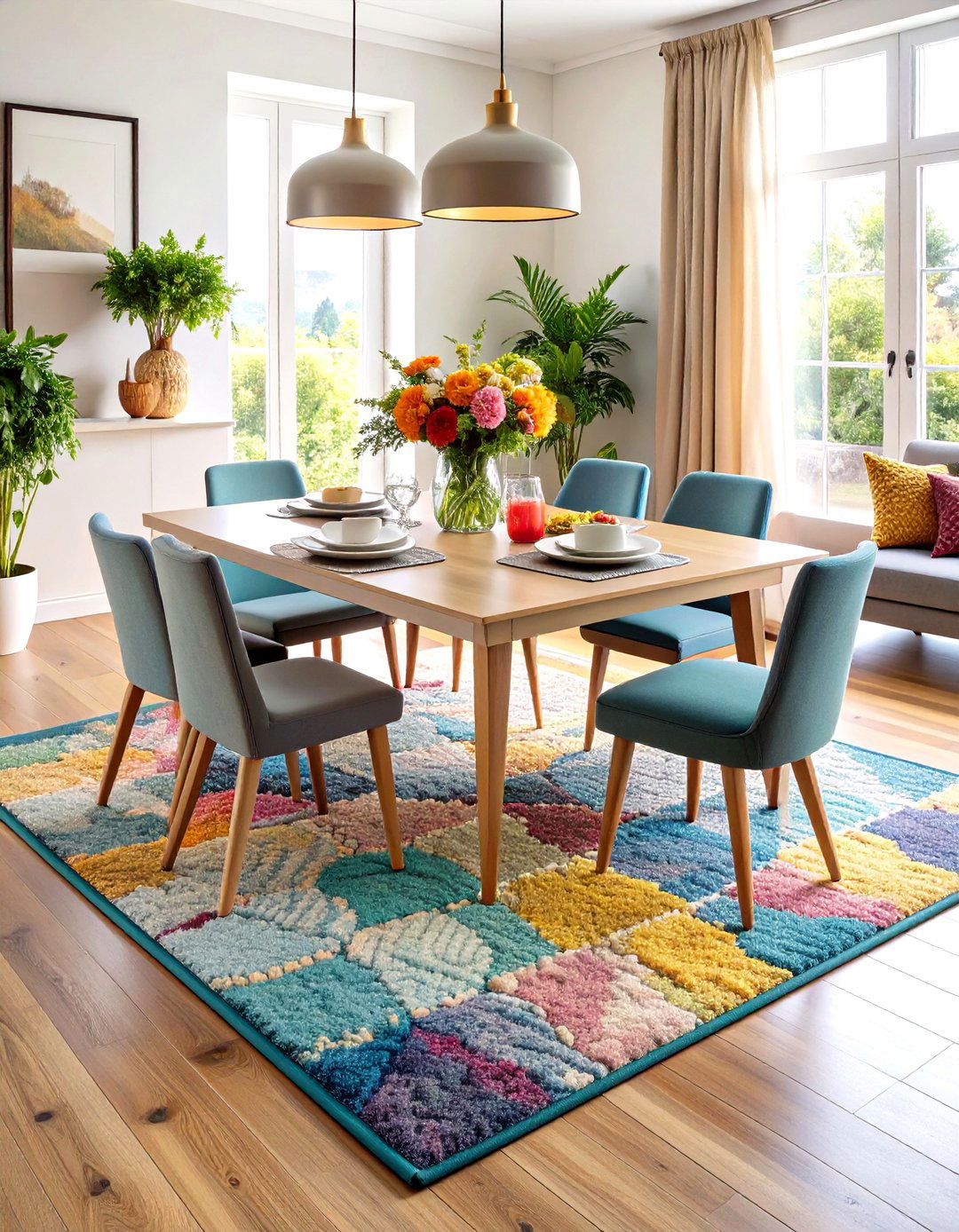
A, washable dining room rug with a removable cover means dinner parties end with dessert, not dry-cleaning bills. Brands like Ruggable and Tumble use lightweight, spillproof toppers that detach and fit in a standard machine, while a nonslip pad stays in place. Ruggable Opt for patterns—think subtle trellis or tonal ombré—to disguise crumbs between wash days, and choose sizes that leave at least 24 inches beyond the table so chairs stay fully on fabric. Because replacement covers cost less than new rugs, you can swap designs seasonally without guilt.
4. Natural Jute Dining Room Rug Adds Organic Warmth
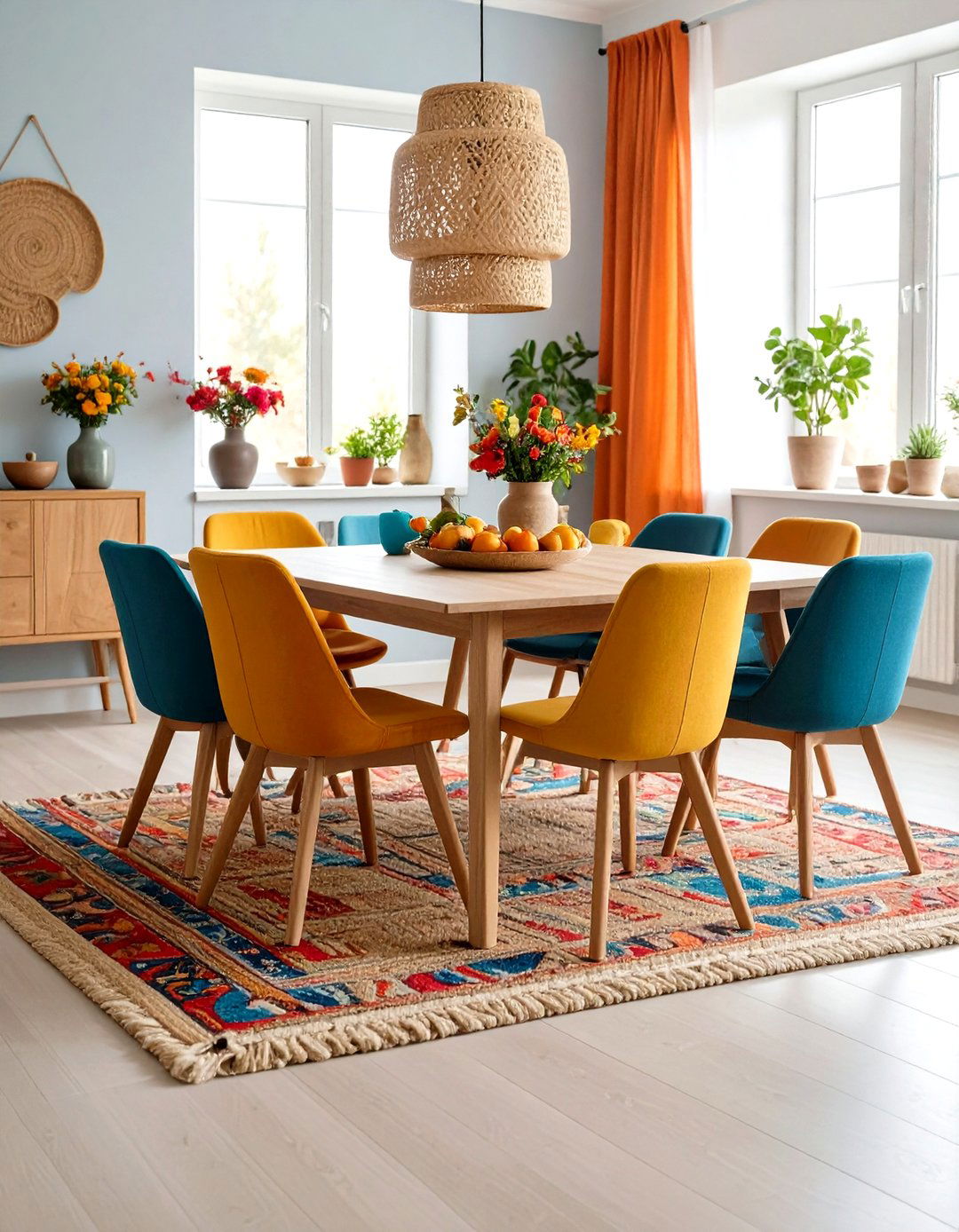
The, tactile weave of a natural jute dining room rug grounds sleek furniture with earthy texture and sustainable credentials. Jute’s neutral wheat and flax hues complement everything from Scandinavian minimalism to colorful boho layers, while fibers harvested with minimal water outperform synthetics on eco scorecards. For comfort, select a braided or boucle style underlaid with felt; this softens coarse strands and dampens chair-pull noise. Pair jute with linen runners and stoneware dishes to create a relaxed, farm-to-table vibe that feels current and environmentally kind.
5. Layered Dining Room Rug Combo for Depth

Consider, layering a slim kilim over a larger sisal dining room rug to add depth and protect pricey patterns. Pinterest feeds show countless examples where a 9×12 neutral base supports a smaller 6×9 accent, creating a generous footprint while framing the table like a picture mat. Pinterest Keep chair legs on the larger rug only; this prevents rocking while letting the top layer shine. Mix textures—think rough sisal under soft wool—to invite bare-foot comfort and visual richness. Change the accent rug seasonally for instant room refresh without moving furniture.
6. Round Dining Room Rug Echoes Circular Table
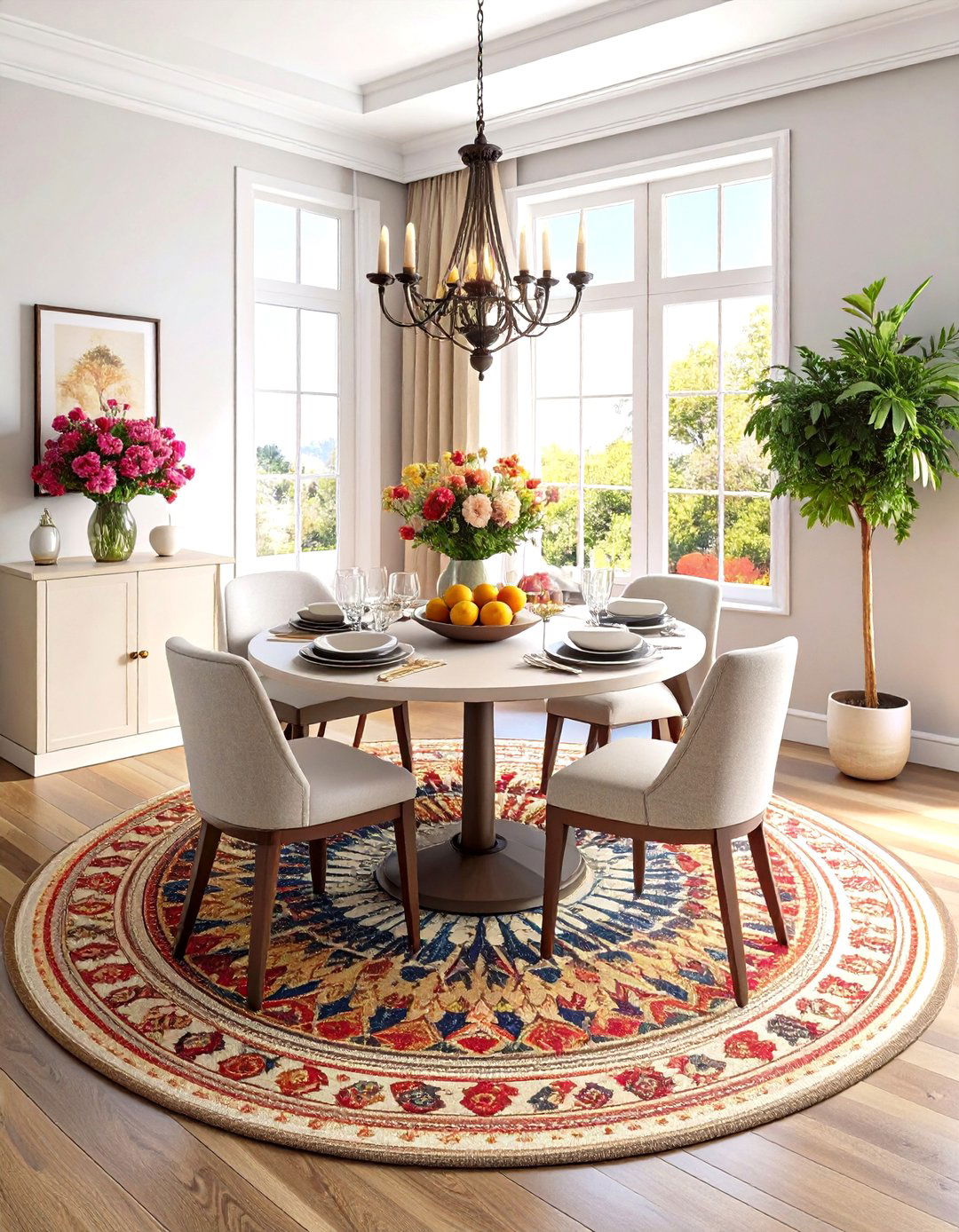
Unlike, rectangular rugs that can dwarf a compact eat-in nook, a round dining room rug mirrors a pedestal or café-style table and keeps walkways clear. Retailers say 4- to 6-foot diameters suit bistro sets, while an 8-foot round comfortably frames a 60-inch table with chairs pushed out. Rugs Direct Surya Living Choose a low-pile wool blend so chairs slide smoothly, and center the chandelier directly overhead to reinforce the circle motif. Patterns radiating from the center—sunburst, mandala, or concentric rings—enhance the symmetry and make the small dining zone feel purposeful.
7. Checkerboard Dining Room Rug Makes Graphic Statement
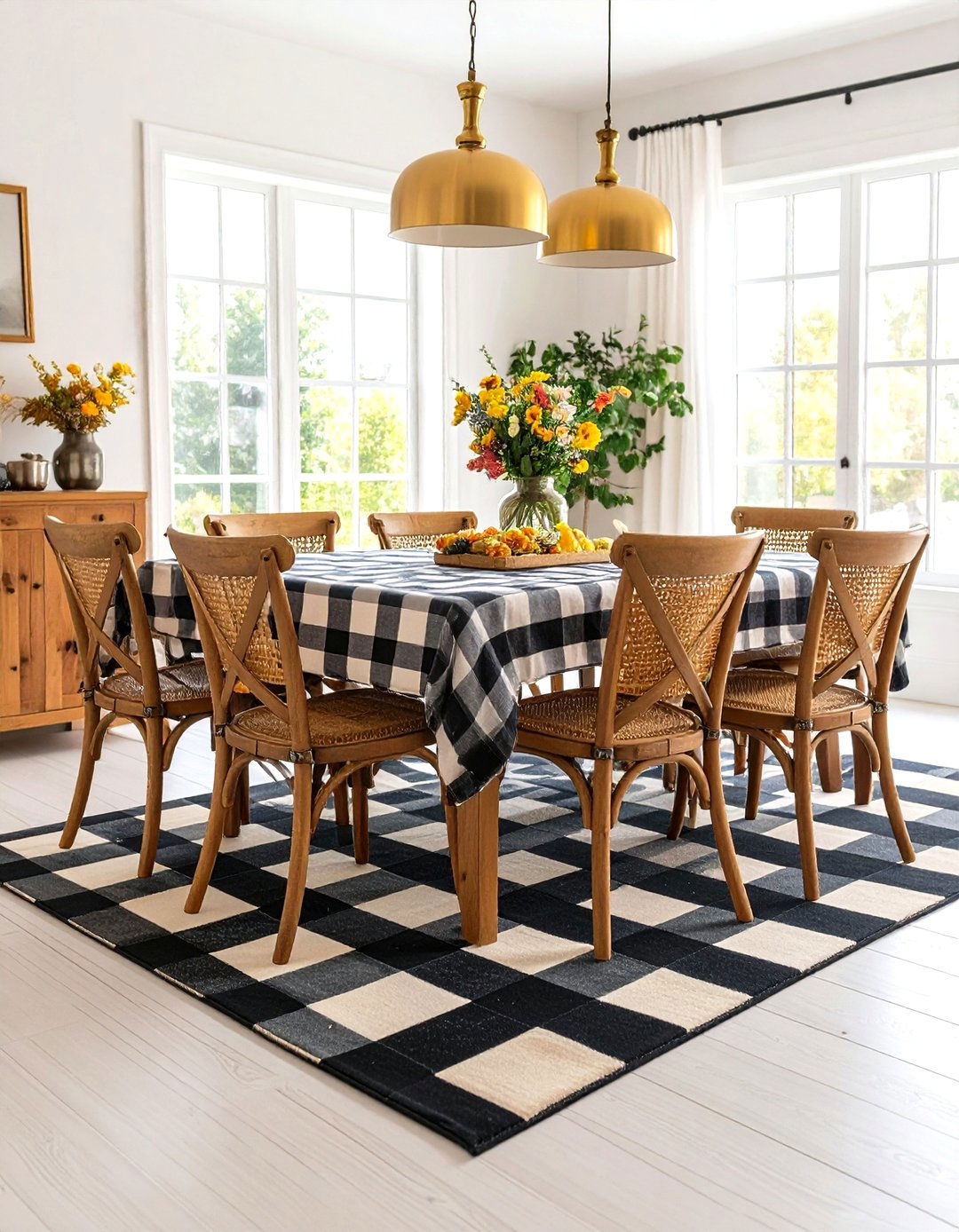
Surprisingly, the classic checkerboard dining room rug is back in 2025, offering graphic punch to minimalist and traditional spaces alike. Design trend trackers note that the pattern’s high-contrast squares “give a graphic punch” and partner well with wood tones and brass fixtures. Crypton FLOR Opt for tonal neutrals—charcoal and ivory—if you fear optical overload, or lean into fashion’s dopamine décor with pastel lilac and marigold. Keep surrounding fabrics solid so the rug takes center stage, and add a simple table runner in one of the rug’s hues to tie the look together.
8. Distressed Vintage Dining Room Rug Brings Character

What, feels more welcoming than a dining room rug that looks lovingly worn from generations of gatherings? Distressed wool or polyester reproductions capture abrash fading and abridged borders without the price tag of antique Oushaks. The Spruce highlights vintage-style pieces for adding texture and warmth, while sourcing guides list hand-picked Anatolian rugs for true one-of-a-kind charm. The Spruce House Beautiful Pair these aged patterns with modern chairs for a curated contrast, and use muted reds or indigos to hide future spaghetti mishaps gracefully.
9. Modular Carpet-Tile Dining Room Rug for Custom Fit

By, snapping together FLOR carpet tiles, you can design a dining room rug in any shape—oval, runner length, or extended rectangle—that perfectly hugs built-in banquettes or open-plan zones. Each tile lifts individually for washing or replacement, so one rogue berry doesn’t doom the whole rug. FLOR FLOR Experiment with gradient layouts or alternate textures for subtle pattern. Because the tiles are thin and bound with non-slip dots, chair legs won’t teeter, and you can carry spares to future homes, making this idea both flexible and waste-savvy.
10. Jewel-Tone Dining Room Rug as Bold Focal Point

Looking, to banish beige? A jewel-tone dining room rug—emerald, sapphire, or the mustard-yellow trending in décor mood boards—instantly lifts spirits and appetite alike. Interiors editors forecast warmer saturated shades replacing cool grays in 2025, and photos of bright blue dining rugs show how a single hue can dictate the room’s palette. Homes & Gardens The Spruce Keep walls neutral and repeat the rug color in napkins or art for cohesion. Select polypropylene or solution-dyed nylon if you worry deep dyes will fade; these fibers lock in vibrancy even under sunny windows.
11. Modern Geometric-Line Dining Room Rug for Minimalist Chic
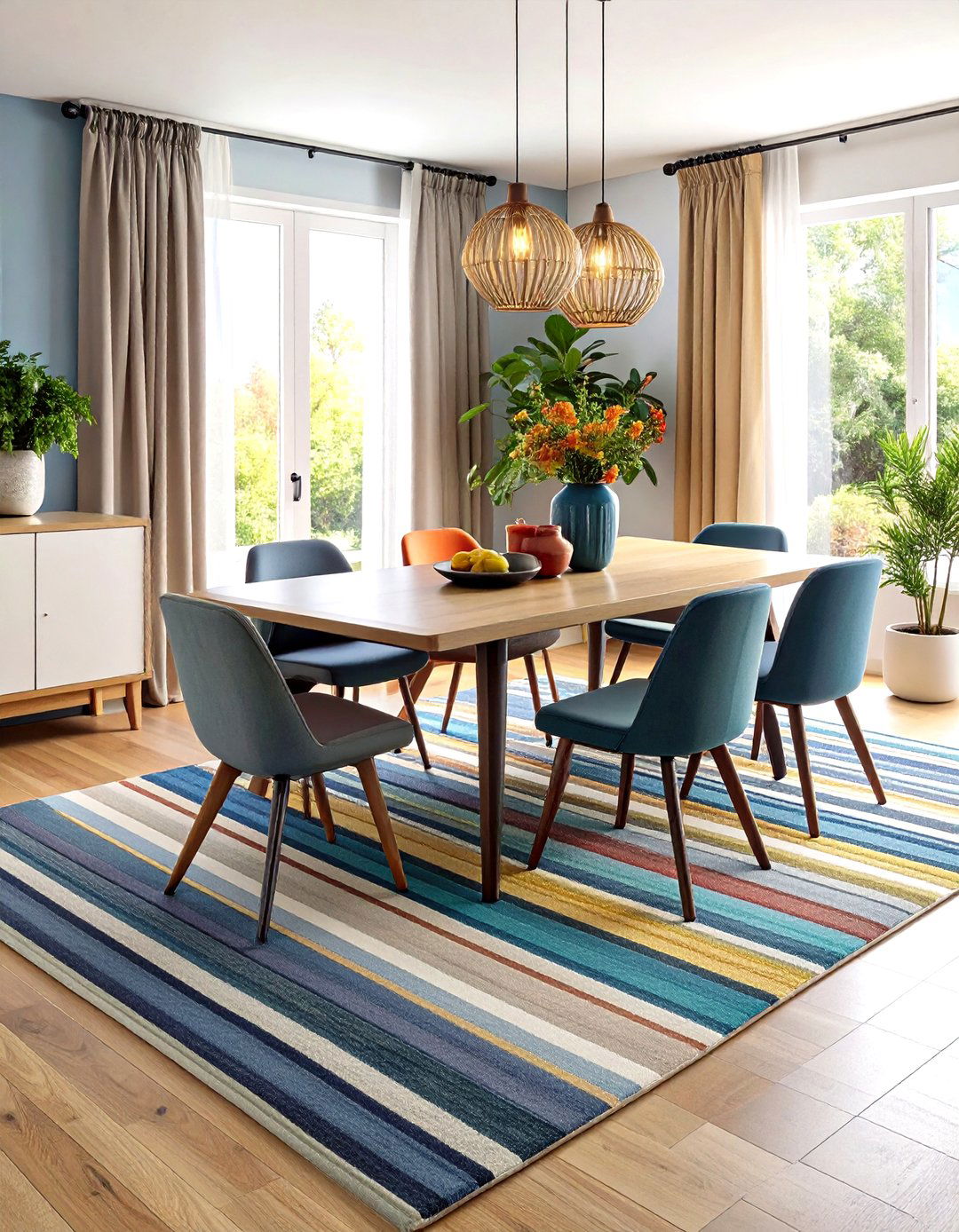
For, clean-lined enthusiasts, a geometric-line dining room rug—think staggered stripes or offset angles—adds subtle movement without busy motif. FLOR’s “Hard Lines” tiles layer high-low pile and random pattern so no two sections align, ensuring a custom modern aesthetic under a Parsons table. FLOR Pair with matte black flatware and linear pendants to echo the motif, and keep colorways monochrome (gray on charcoal, cream on sand) for understated drama that still anchors the zone.
12. Earth-Tone Dining Room Rug Creates Calm Foundation

Despite, maximalist talk, designers still champion earth-tone dining room rugs—camel, rust, olive—to warm spaces and hide daily wear. Trend trackers note heavy cool shades are “going out of style,” replaced by warming organic tones that soothe overstimulated eyes. Homes & Gardens Combine the rug with natural wood tables and linen curtains to craft a cocooning, biophilic dining envelope. Low-contrast palettes also make dishware pop, highlighting the meal rather than the backdrop.
13. Recycled-Fiber Dining Room Rug for Sustainable Style
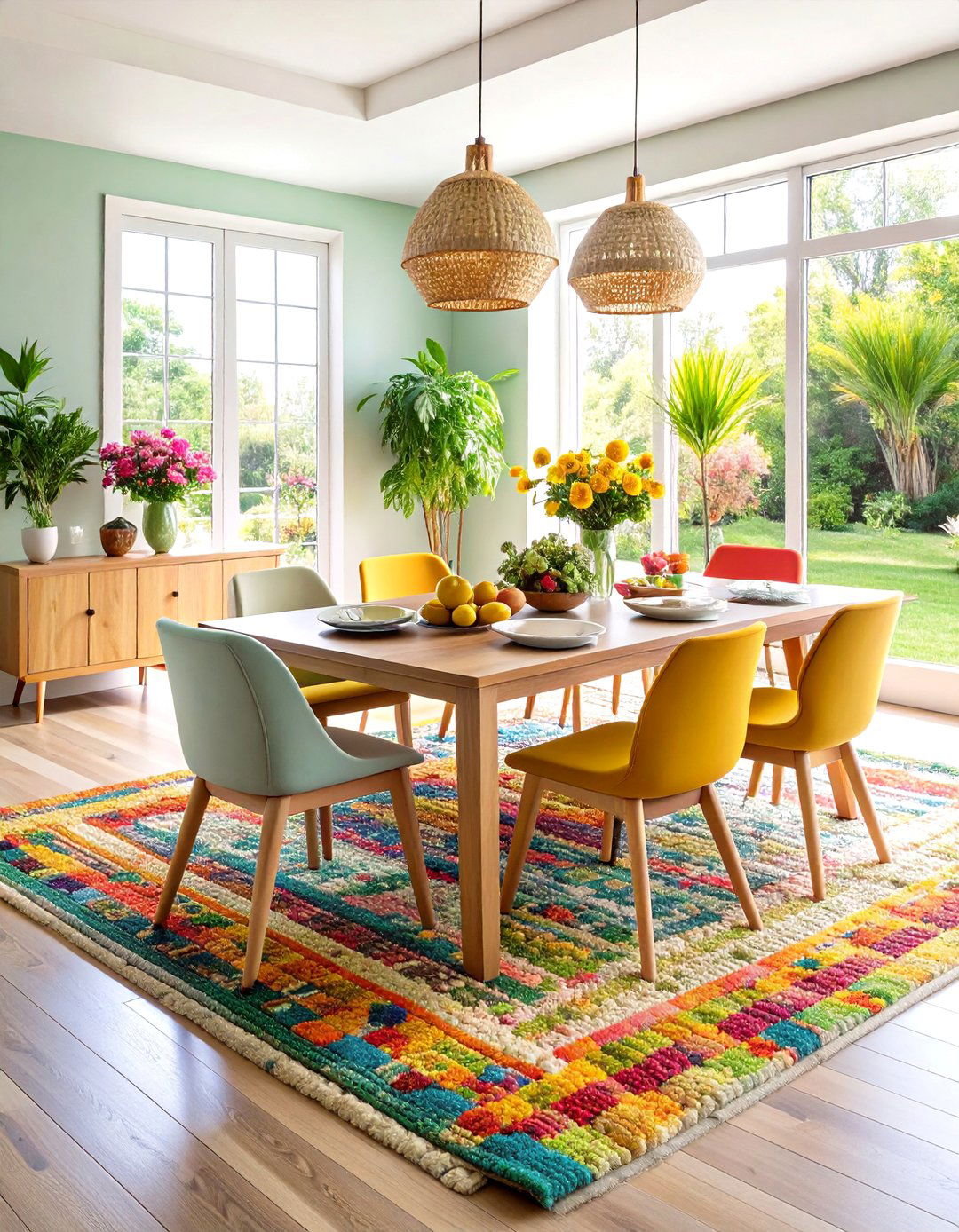
Certainly, eco-minded hosts appreciate a recycled-fiber dining room rug woven from reclaimed cotton or PET made of ocean-bound plastic. Rug trend reports list these materials among 2024’s top must-haves, noting they balance durability with carbon reduction. Homestitch Look for certifications like GRS or OEKO-TEX to confirm ethical sourcing, and choose flatweave constructions for easier end-of-life recycling. Add rattan chargers and vintage glass to extend the sustainability story across the tablescape.
14. Curved-Edge Dining Room Rug Softens Hard Lines
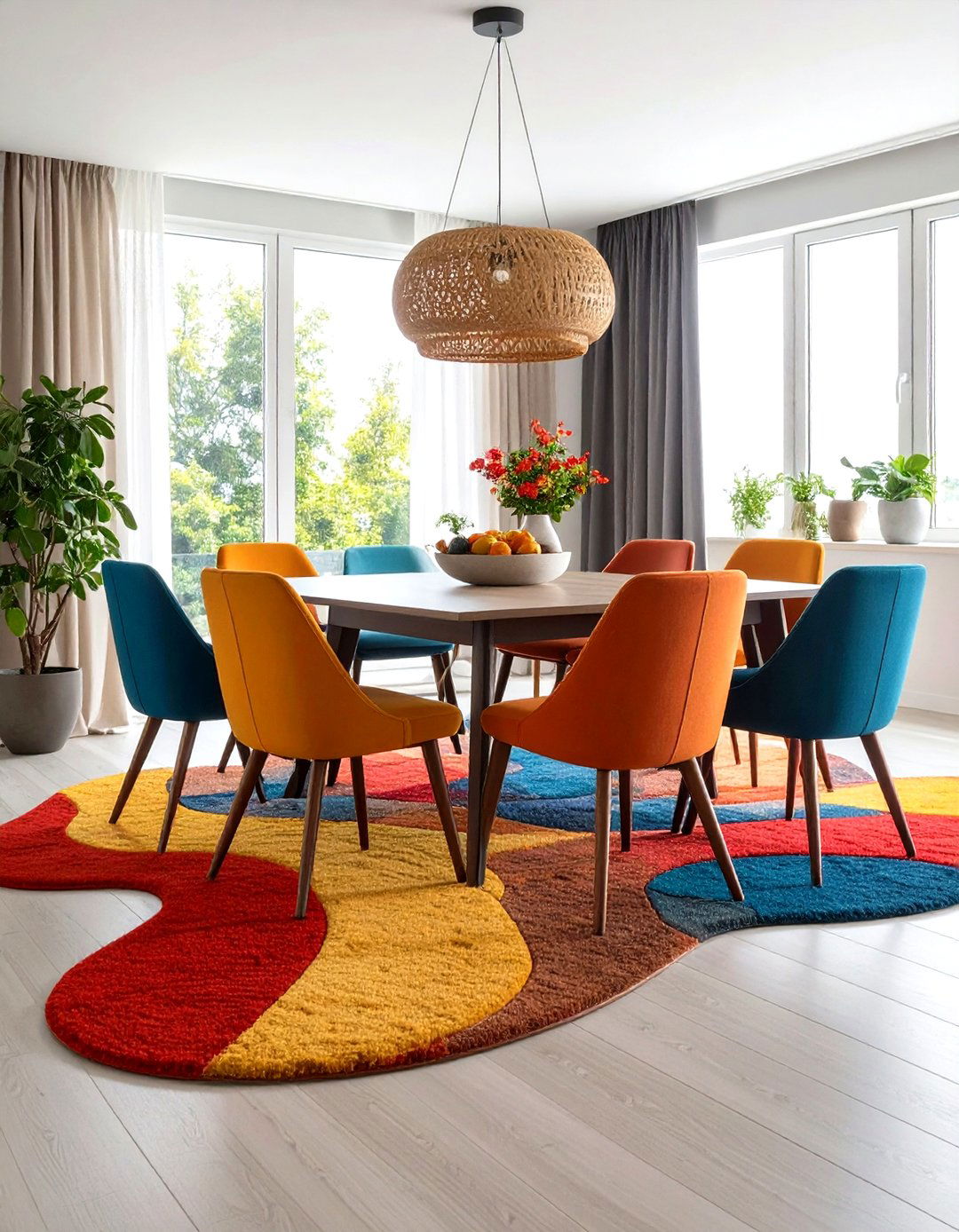
Unlike, rigid rectangles, a curved-edge or amoeba-shaped dining room rug softens boxy architecture and mirrors the resurgence of organic furniture silhouettes forecast for 2024–25. Design analysts predict rectangular rugs will be “replaced by round, oval or organically shaped” options to enhance flow. Decorilla Position the rug so its widest point sits beneath the table’s midpoint, letting the curved border peek out like a puddle of color. Keep chair forms simple so the rug’s playful outline steals the spotlight without visual clutter.
15. Striped Flatweave Dining Room Rug Lengthens the Space
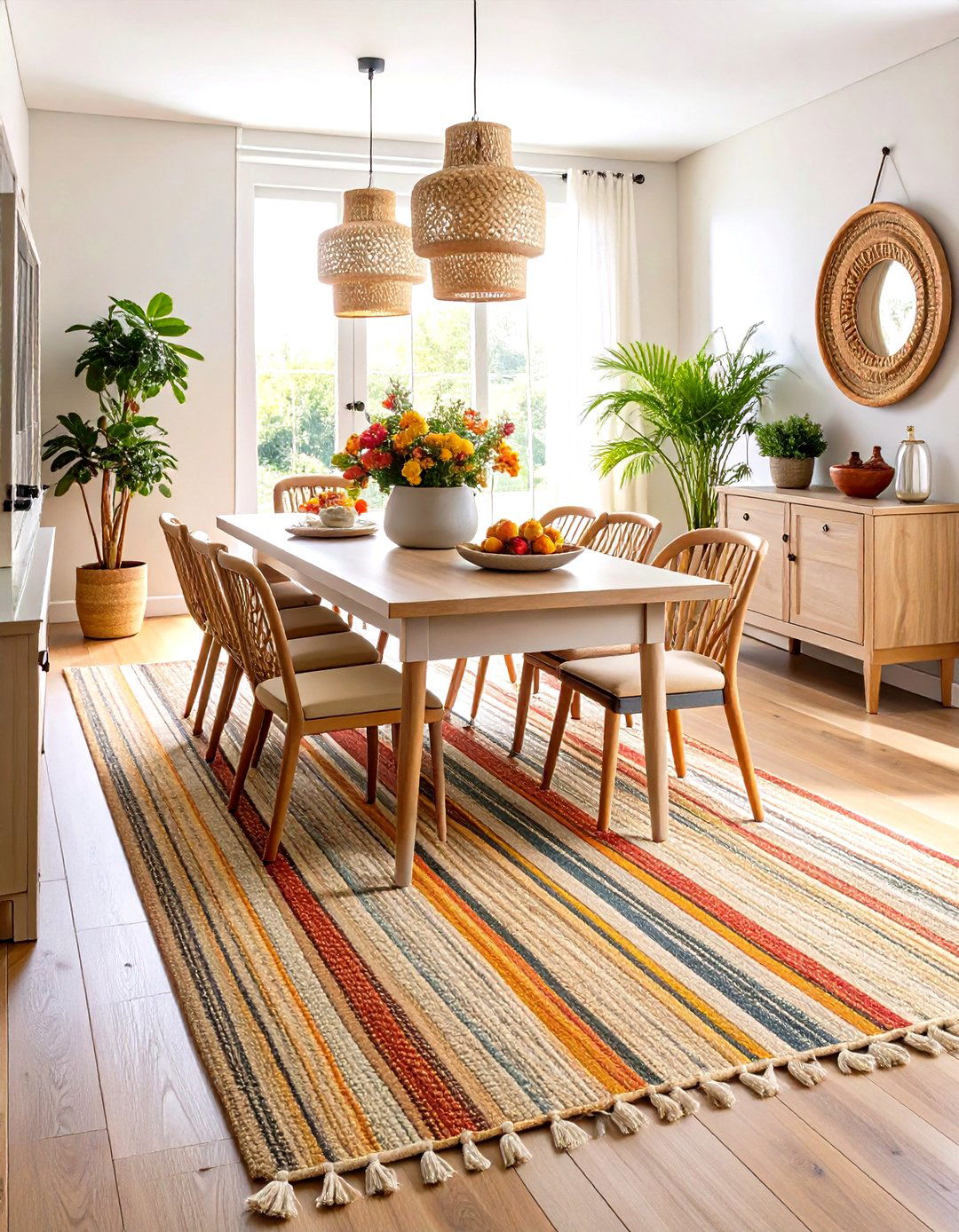
Take, a striped flatweave dining room rug to visually stretch a narrow room; orient lines parallel to the longest wall so the eye travels with them. The Spruce showcases tasselled stripe rugs that inject earthy texture while remaining low-pile for effortless chair movement. The Spruce Choose cotton-wool blends for softness, and limit the stripe palette to two or three tones to avoid dizziness. The thin construction rolls up easily for deep cleaning or seasonal swaps, making it apartment-friendly.
16. High-Contrast Black-and-White Dining Room Rug Elevates Drama
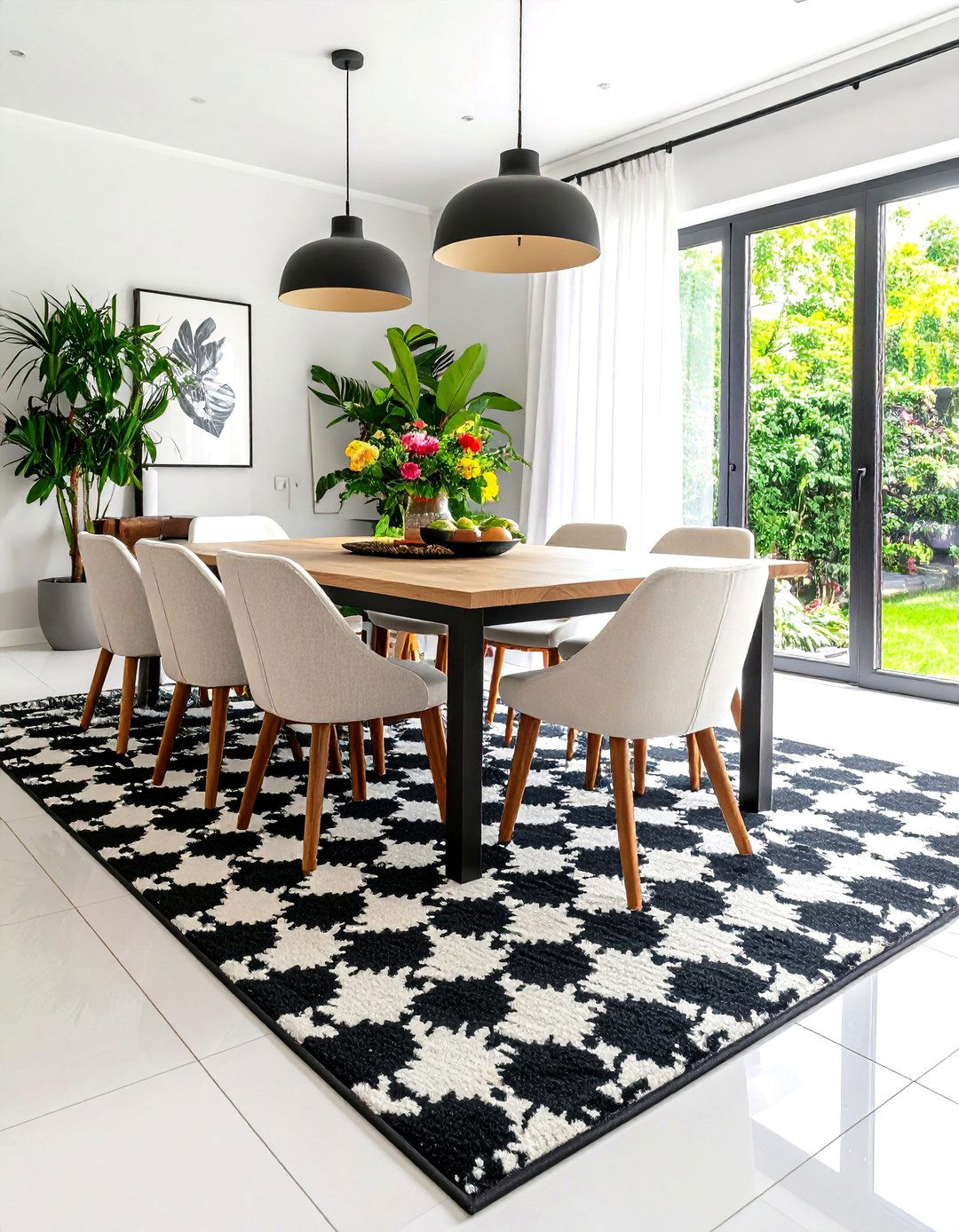
Despite, minimalist leanings, monochrome drama is still welcome: a high-contrast black-and-white dining room rug (think oversized houndstooth or polka dot) serves gallery vibes under sleek lighting. Examples in design galleries show bright white rugs lightening deep charcoal walls and vice versa, proving contrast can brighten rather than darken. The Spruce Keep tabletop décor restrained—matte black plates or crisp white linens—to let the rug act as visual anchor rather than competing pattern.
17. Low-Pile Wool Dining Room Rug Offers Everyday Luxury
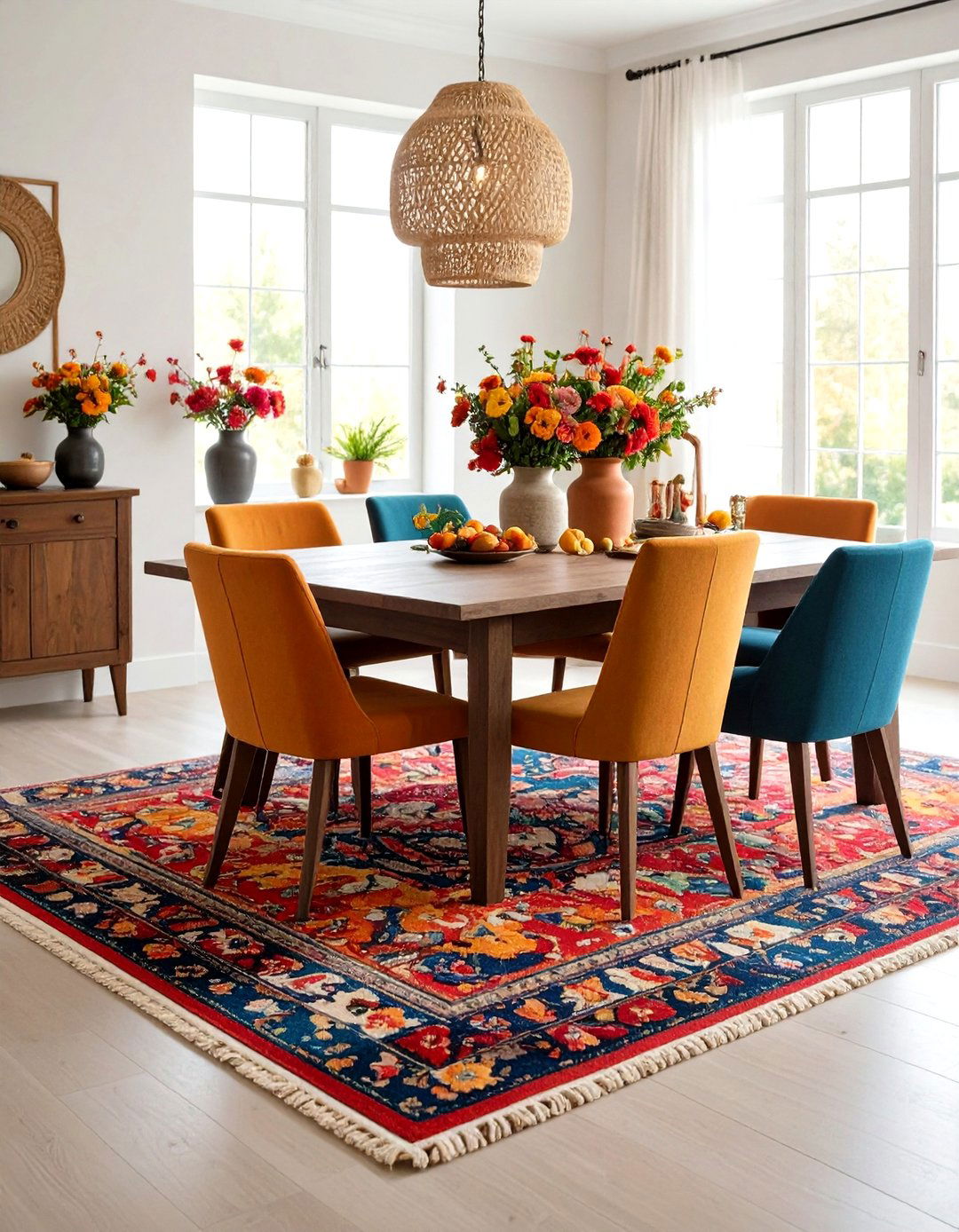
From, a performance standpoint, wool remains the gold standard for dining room rugs: naturally stain-repellent lanolin and springy fibers survive thousands of chair scoots. Material guides praise wool as “durable, soft, and water- and dirt-repellent,” making it ideal for high-traffic areas. The Spruce Aim for a pile under ¼-inch to prevent denting and ease vacuuming, and consider a subtle tone-on-tone pattern to mask fork fallout while preserving understated elegance.
18. Oversized 9×12 Dining Room Rug Ensures Chair Comfort

When, in doubt, size up: experts advise choosing a dining room rug large enough that chairs stay fully on fabric even when pushed back—about 24–30 inches beyond tabletop edges. A 9×12 rectangle comfortably frames most seven-piece sets, according to Home Depot’s sizing guide, while small apartments can downsize to a 4- or 6-foot round for bistro sets. The Home Depot This generous perimeter prevents trip hazards, protects flooring, and looks professionally tailored.
19. Plush Micro-Shag Dining Room Rug for Cozy Dinners
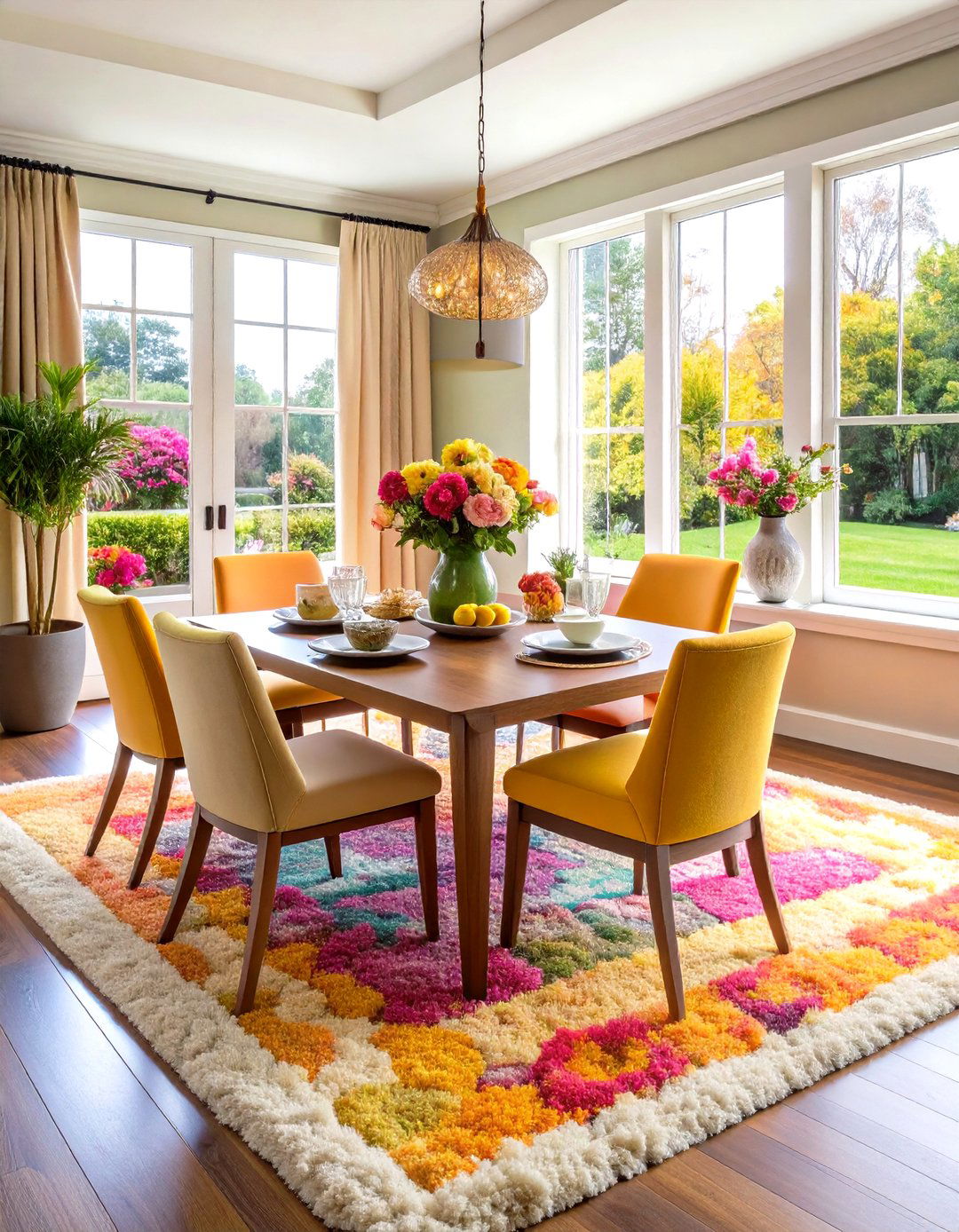
Although, high-pile rugs were once taboo under dining tables, new low-shedding micro-shag constructions offer cloud-soft comfort without hiding crumbs forever. Independent testing on top-rated area rugs found synthetic shags scoring highly in cleanability and resilience thanks to tightly twisted fibers. The Spruce Reserve this idea for breakfast nooks where shoes are off, pair with cushioned felt pads, and keep a cordless stick vacuum handy for daily touch-ups. The tactile luxury encourages guests to linger long after coffee is poured.
20. Seasonal Swap Dining Room Rugs Keep Décor Fresh
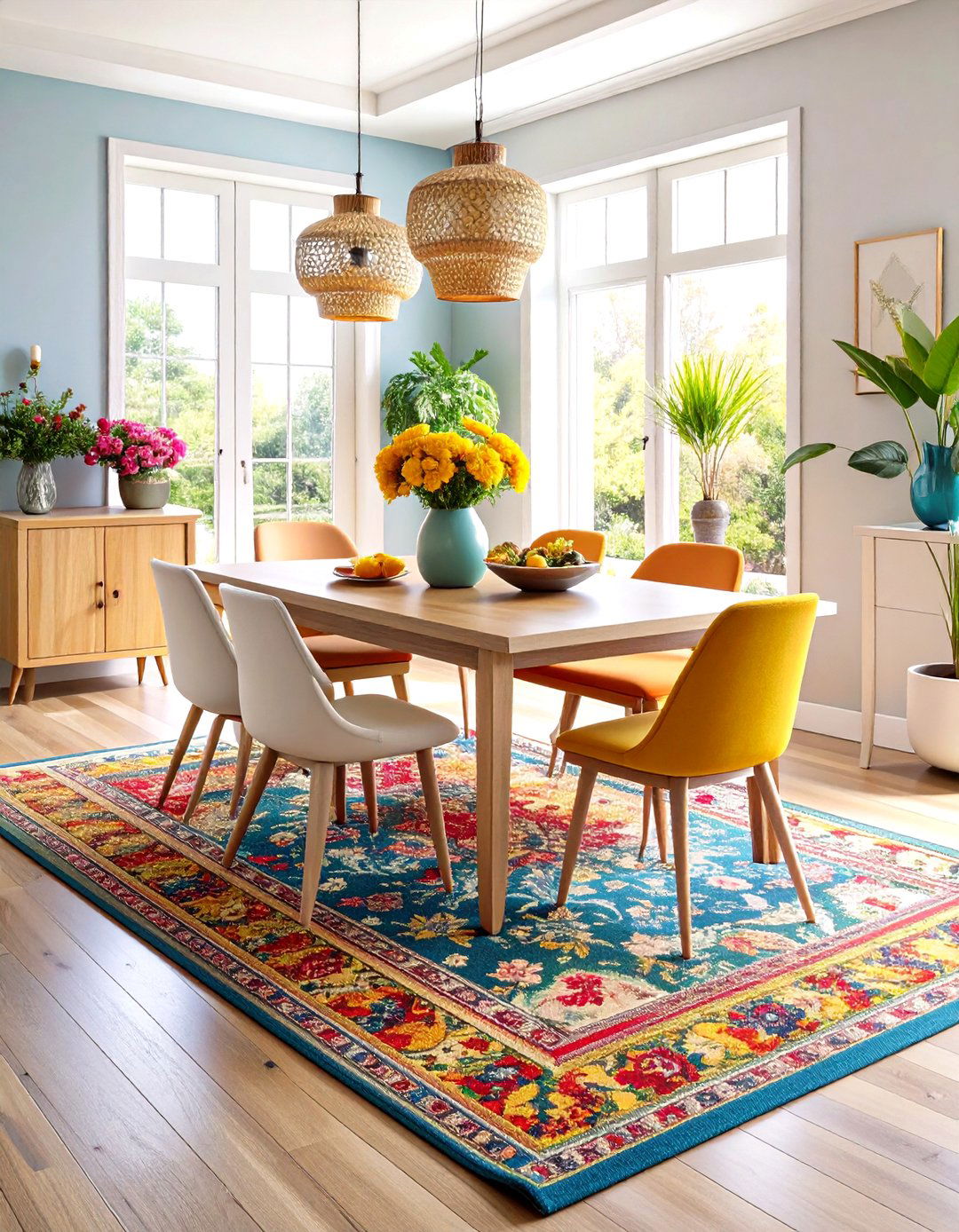
Finally, rotating two dining room rugs—say, a light sisal for summer and a deep color-saturated wool for winter—extends rug life and refreshes style on cue. Sales events like Wayfair’s July flash sale make acquiring a second rug surprisingly affordable, while modular tiles let you reconfigure without storage bulk. Southern Living FLOR Store the off-season rug rolled in breathable cotton, then swap as daylight and menus change. This practice prevents sun-fading, spreads wear evenly, and keeps your dining room feeling newly decorated twice a year with minimal effort.
Conclusion:
Whether you crave the time-honored elegance of a Persian weave, the kid-proof practicality of machine-washable covers, or the sculptural allure of curved edges, the perfect dining room rug exists to complement your table and lifestyle. Embrace sustainable fibers, right-size generously, and don’t shy away from bold patterns that reflect personal taste. Viewed together, these twenty ideas prove that the floor beneath your meals can be as memorable as the dishes served above it.


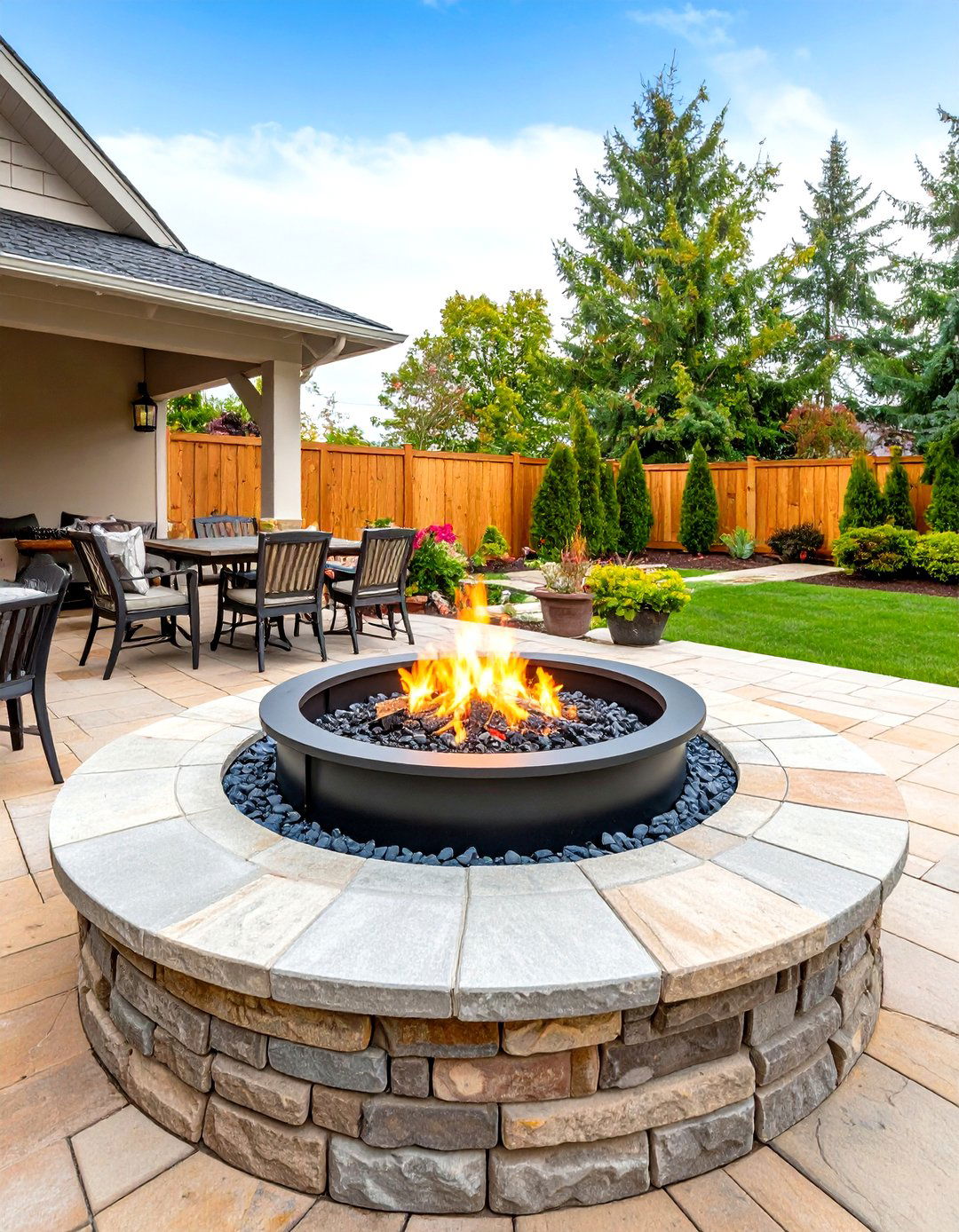
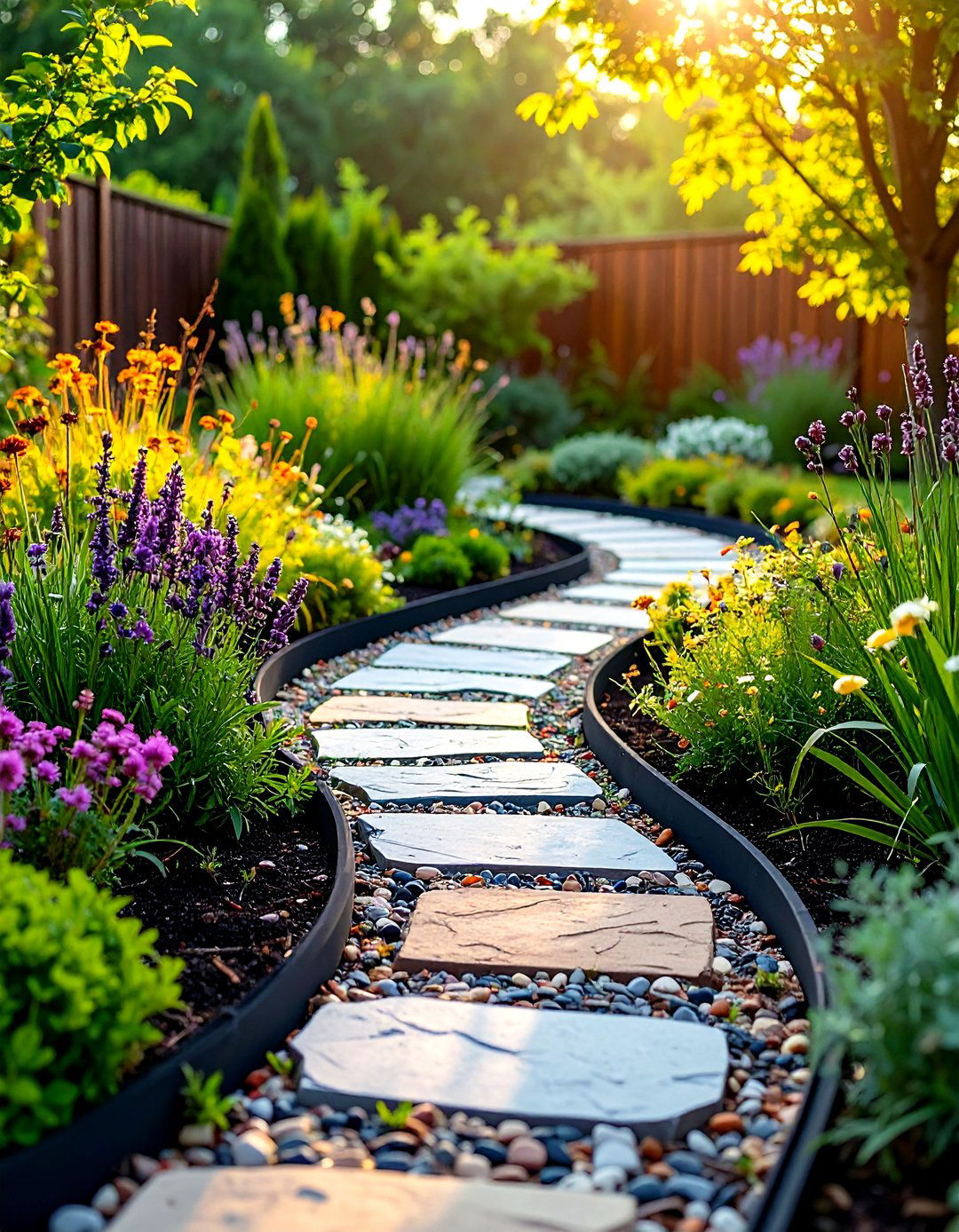

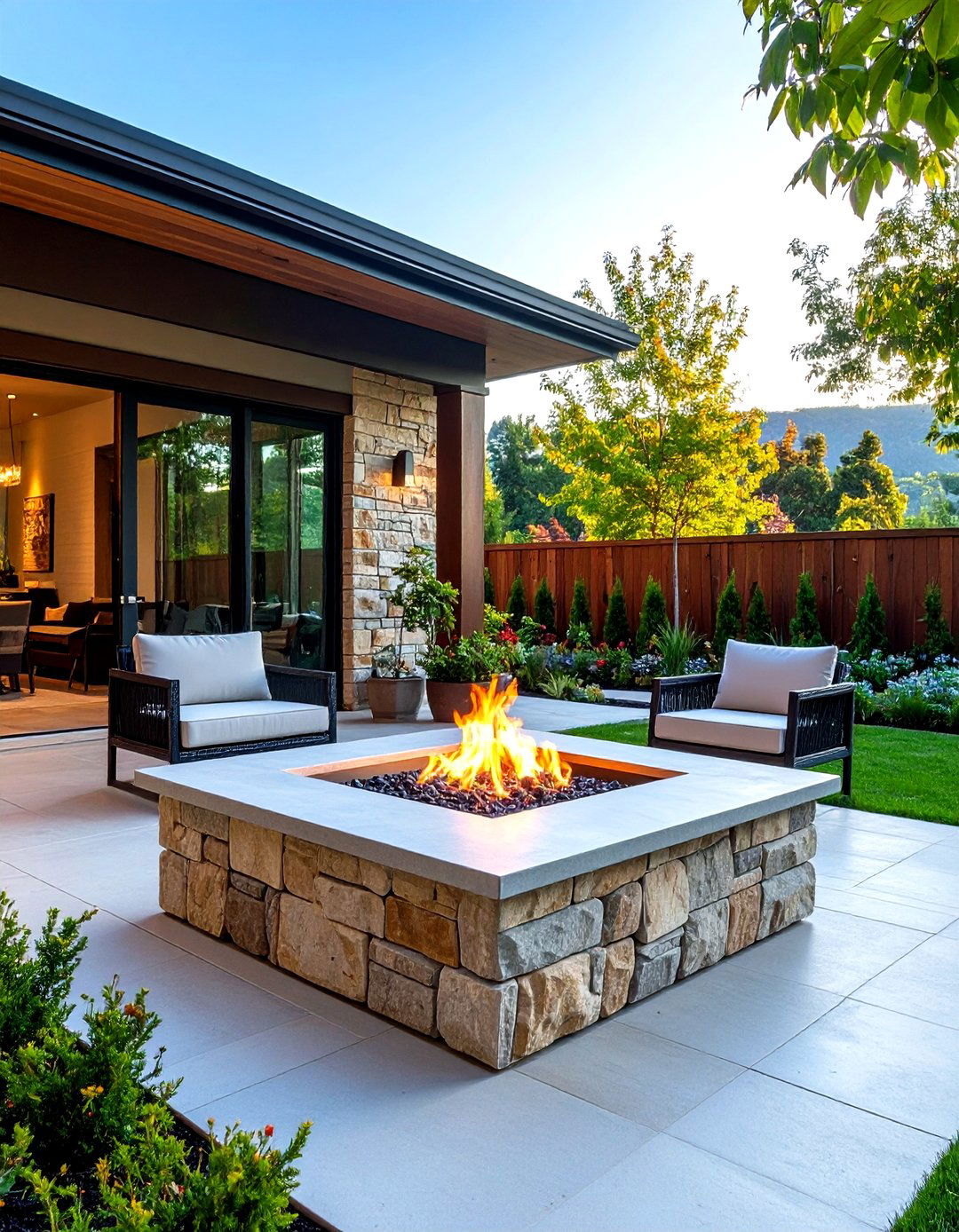
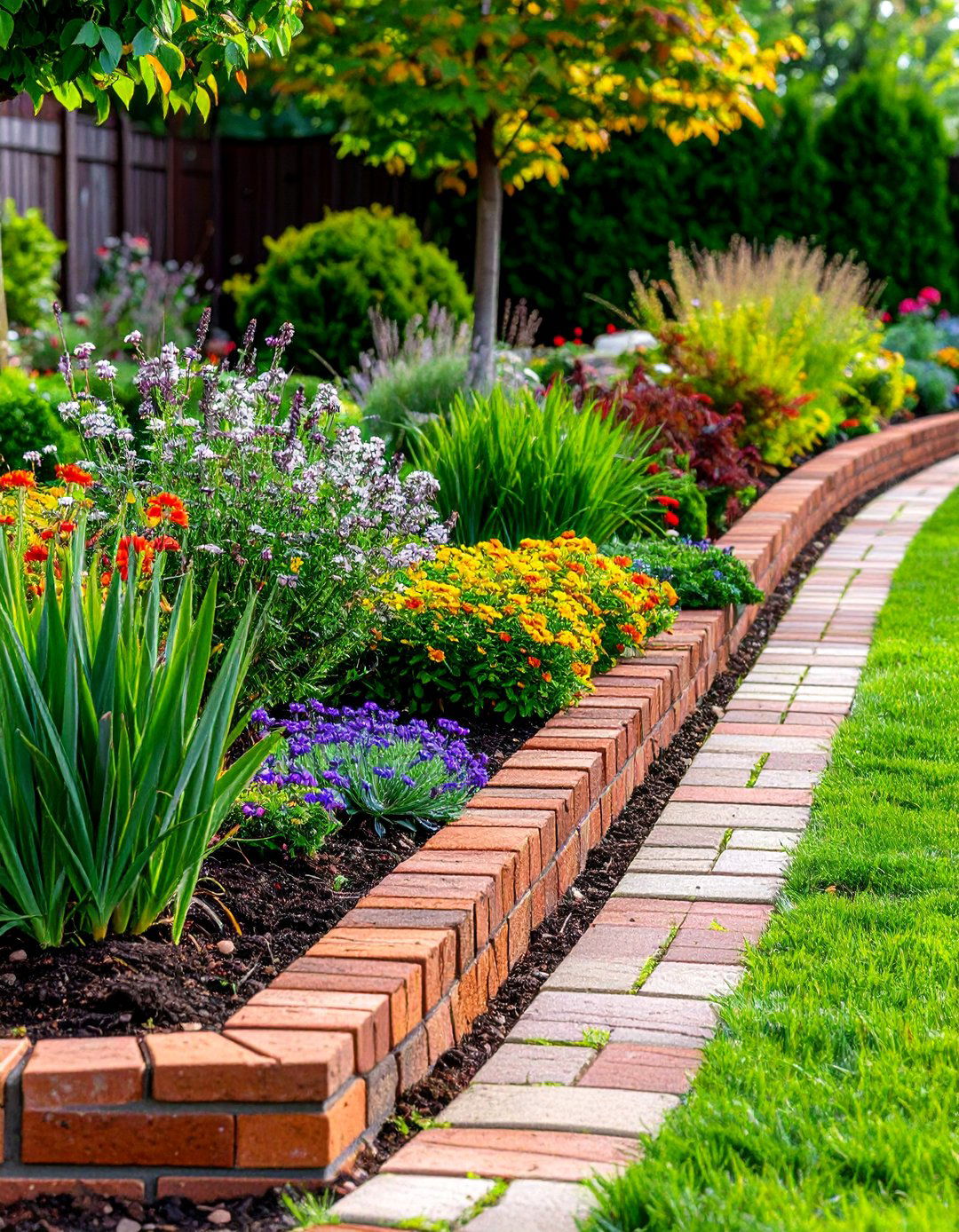
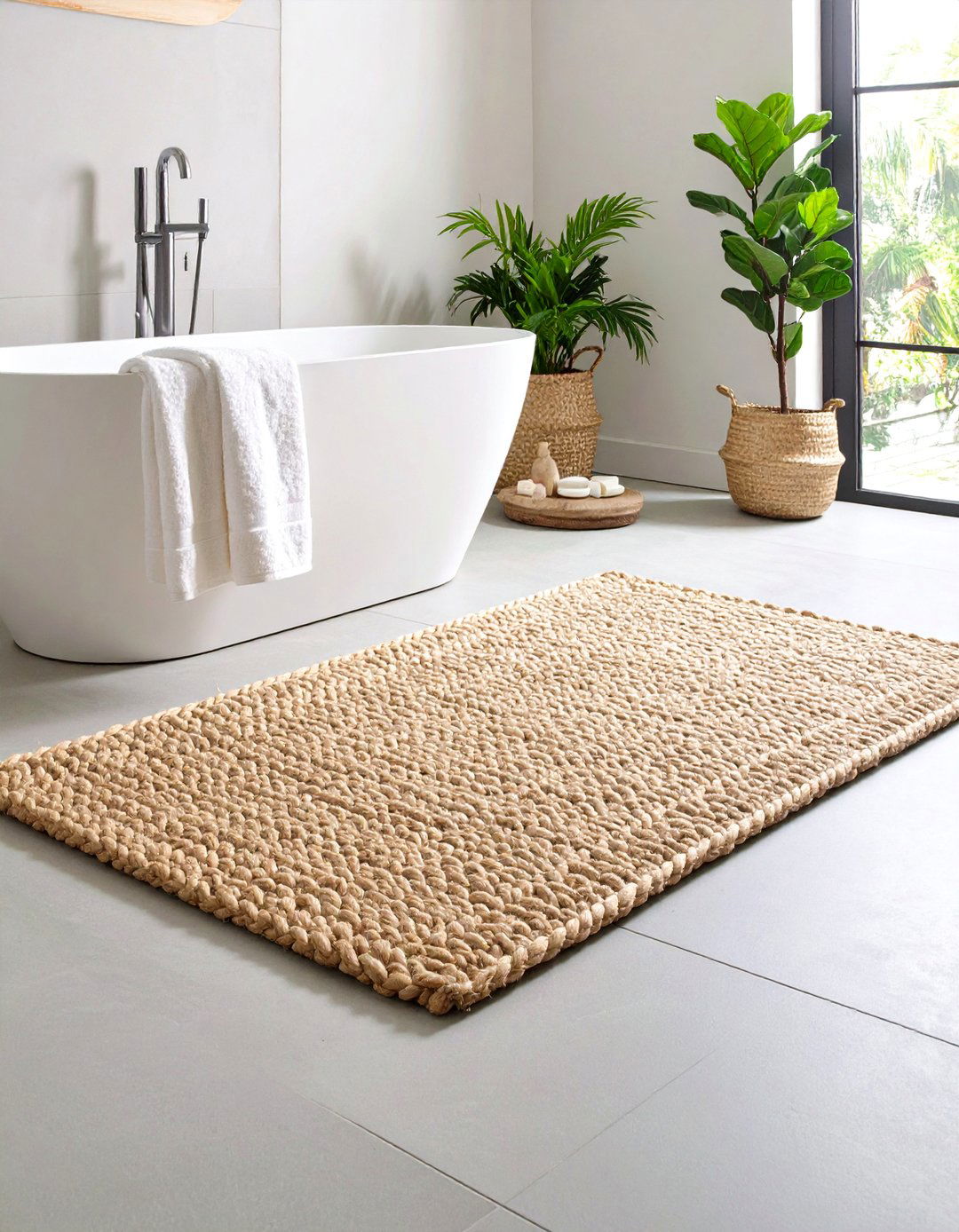
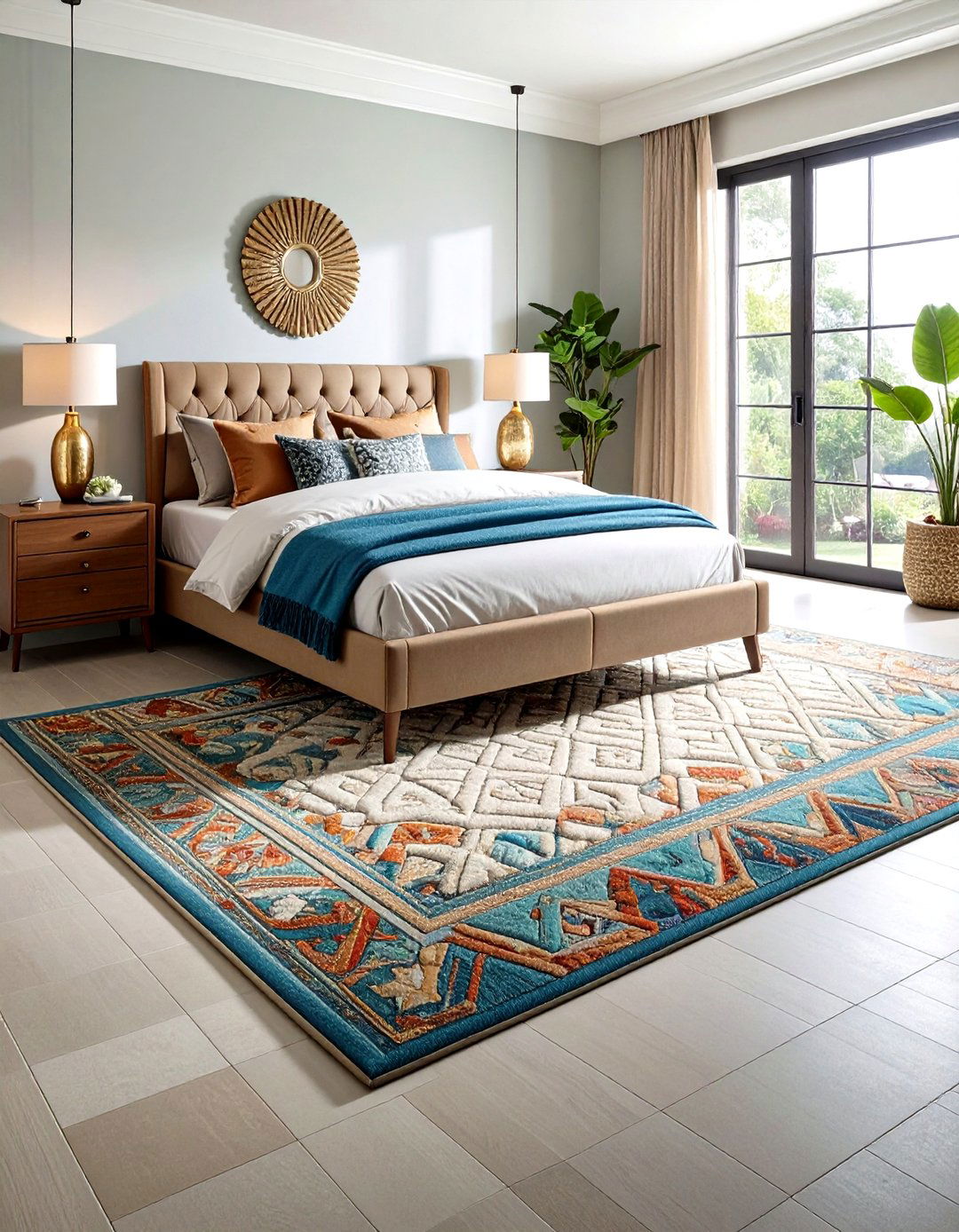




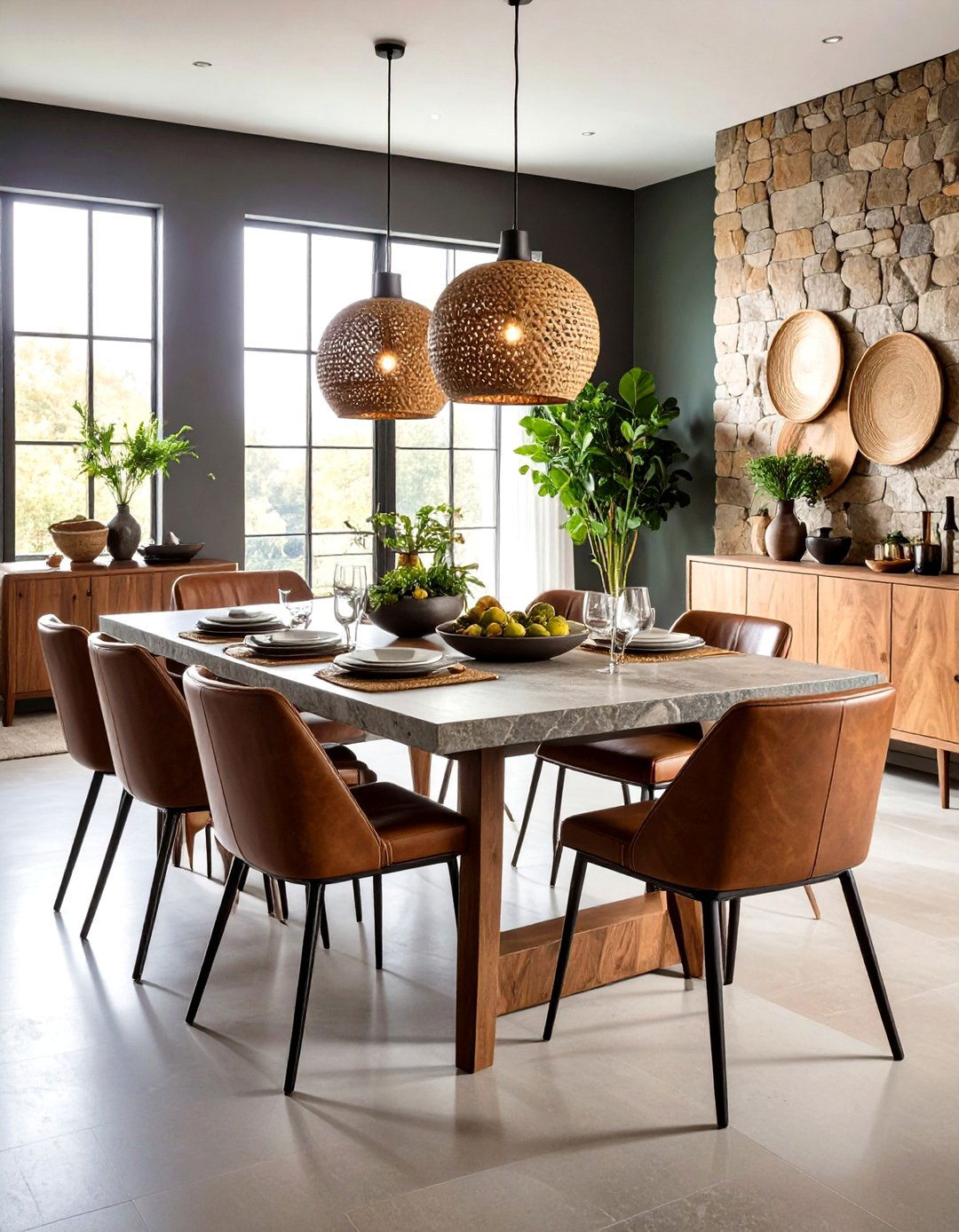
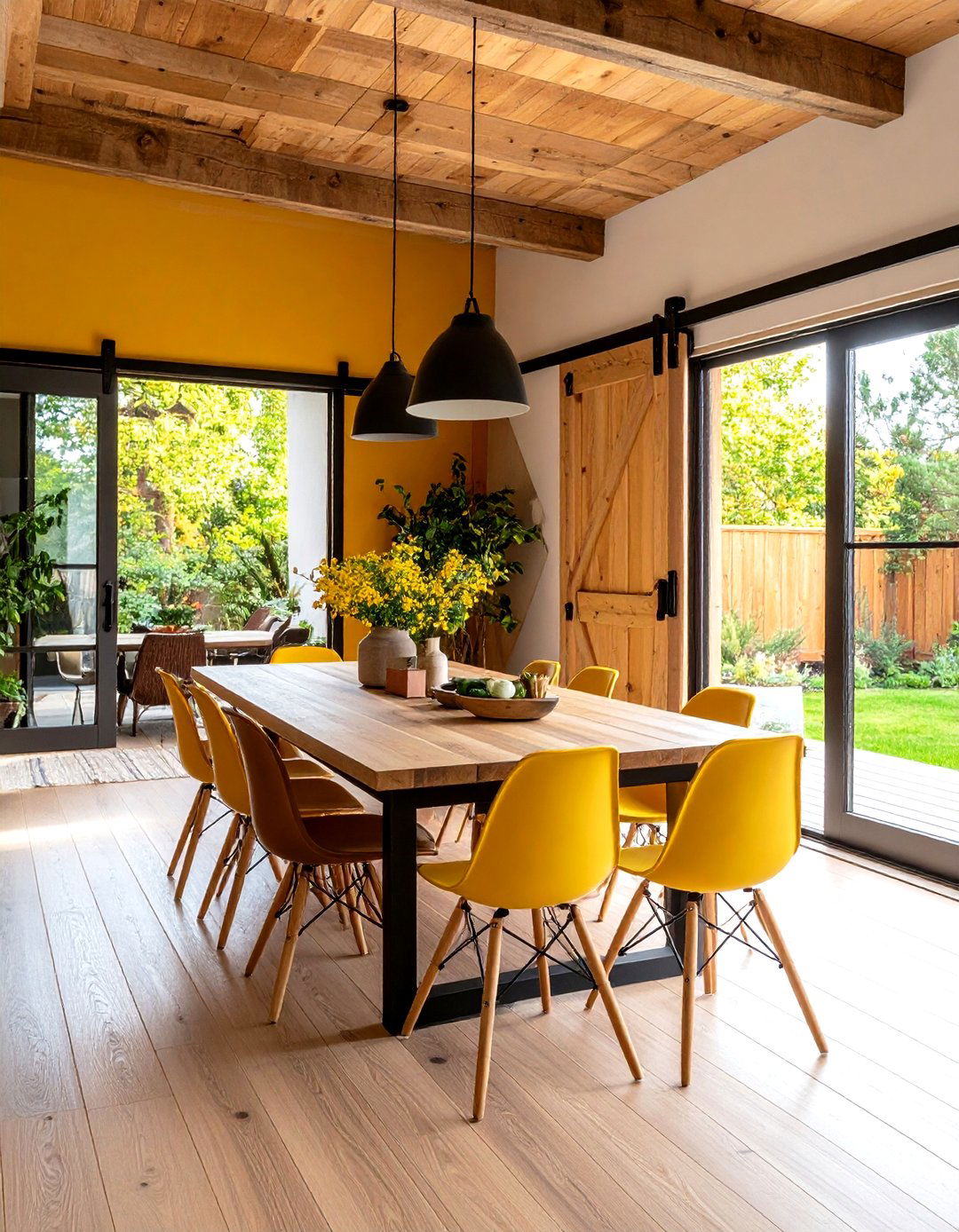
Leave a Reply